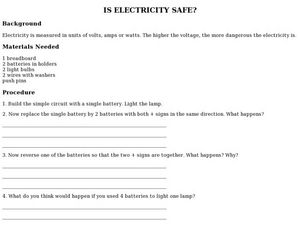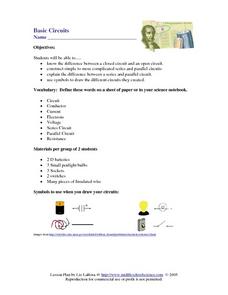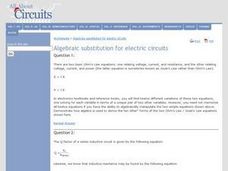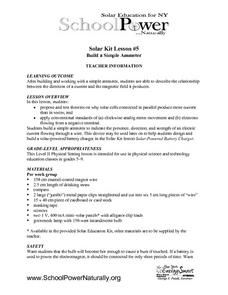Curated OER
What is Electrical Potential and How Does a Relational Causal Model Explain It?
Pupils examine models of electrical potential. Students discuss the concept of electrical potential and relational causality. They compare models based on electric potential to those with cyclic simultaneous causality.
Curated OER
A simple computer
In this circuit instructional activity, students build a circuit simulating a simple computer using light bulbs, breadboards, push pins and more. Students then complete a chart and answer 1 question.
Curated OER
Parallel circuit
In this parallel circuit worksheet, students use batteries, a breadboard, light bulbs and more to make a parallel circuit and answer short answer questions. Students answer 2 questions.
Curated OER
Is Electricity Safe?
In this scientific investigation activity, learners follow the provided procedures to examine the safety of electricity and then respond to 3 short answer questions.
Curated OER
Series and Parallel Circuits
Students explore the differences between a parallel and a series circuit.In this current lesson students complete several experiments using a light bulb.
Curated OER
Electricity: Series and Parallel Circuits
Fourth graders explore electricity and electrical circuits. They explore series and parallel circuits using Christmas lights. Students pull lights out of each strand of lights. They observe the results when the light bulb is pulled out....
Curated OER
Basic Circuits
Students explain the difference between a closed circuit and an open circuit. They construct simple to more complicated series and parallel circuits. They explain the difference between a series and parallel circuit.
Curated OER
Algebraic Substitution for Electric Circuits
For this physics worksheet, students use Ohm's law to solve for voltage, current and resistance. They answer 13 problem solving questions using Ohm's law.
Curated OER
Electrical Circuits
In this electrical circuits worksheet, learners read a text and examine a diagram to learn the parts of a simple electric circuit. Students then answer 6 questions about electrical circuits. This is an online interactive worksheet.
Curated OER
Circuits and Conductors
Fourth graders investigate the concepts of circuits and conductors. In this circuits and conductors lesson set, 4th graders watch demonstrations of circuits and look at images to identify whether they are complete circuits. They test...
Curated OER
Light the Bulb
Students explore electricity. In this power experiment lesson, students determine what is required for lighting a bulb. Students develop an understanding of open and closed circuits, and how energy is formed
Curated OER
Parallel Circuits
Students investigate the way an electrical circuit works. In this physics instructional activity, students use voltmeters and ammeters to measure voltage. They construct a circuit using provided circuit kits.
Curated OER
Electricity
Learners experiment with a series of circuits. In this chemistry lesson, students discuss voltage, resistance and current as they flow through an electrical circuit. They work in pairs to solve the questions.
Curated OER
Electricity
Young scholars identify the relationship between batteries, circuits and voltage. In this physics lesson, students investigate the way batteries are put into different apparatus. They discuss why different machinery need different...
Institute of Electrical and Electronics Engineers
Electric Messages: Then And Now
Learners engage in a instructional activity that is concerned with the history of communication devices that are used today and in the past. They practice using morse code as a look into the past and then cover the modern subjects of...
Curated OER
Student Exploration: Circuit Builder
In this circuit builder worksheet, students use the Circuit Builder Gizmo to answer 15 questions and complete charts about different kinds of circuits. Students will need to have access to the online Gizmo to complete the worksheet.
Teach Engineering
Building a Piezoelectric Generator
In pairs, learners build a piezoelectric generator from readily available electric components in the second and final installment of the two-part series. Tapping the piezoelectric element produces enough electricity to light an LED....
CK-12 Foundation
Galvanometer
In 1820, Hans Christian Orstead discovered the link between electricity and magnetism, which allows us to measure current and voltage. The simulation allows scholars to observe the inner workings of an ammeter and voltmeter as they...
Bonneville
Simple Solar Tracker
Let the solar cells fight each other for supremacy! Given a functional solar tracker that moves toward light, groups copy the design to build their own devices. They use two sets of solar cells that have reverse polarization, so that the...
Curated OER
Electricity: Going with the Flow!
Fifth graders explore a simple circuit. They experiment with a wire, light bulb and a bettery to see how many ways they can make the light bulb light up. Students describe how they were or were not ablt to light the bulb.
Curated OER
Electric Circuits
Fourth graders investigate complete and incomplete circuits. Using an electrical kit that includes a D-cell battery, wiring, and a flashlight bulb, they construct a complete electric circuit that will light the light bulb. Students...
Curated OER
Build a Simple Ammeter
Students build and work with a simple ammeter to test theories on why solar cells connected in parallel produce more current that in series. Students use the ammeter to indicate the presence, direction, and strength of an electric...
Curated OER
Electricity
Students examine basic electrical components. They build a simple electrical circuit which rings a buzzer. They experiment with conducting and nonconducting materials.
Curated OER
Flick the Switch
After reading a short paragraph on how electrical switches work, learners look at four examples of electrical circuits, and circle the ones which will allow a lightbulb to be lit. This would be a good precursor to having your charges...

























